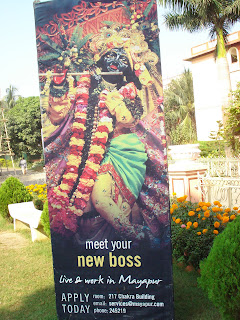A little girl of age five was visiting her maternal grandpa's place in Kolkata. One day she accompanied her mother to the market. She was holding her mother's hand as they walked passed different shops. They came across a small temple in the market. The little girl's mother stopped there and told her that it was Goddess Kali's temple. The mother bowed to the Goddess and offered prayers as the little girl looked on with curious eyes. Just then a priestly man brought a goat inside the temple with garland around its neck. People started to assemble and the mother realizing what would happen next decided to leave. The curious little girl wanted to know what was going on and wanted to stay like all the other bystanders. The mother briefly explained that the goat will be sacrificed. The little girl couldn't comprehend and questioned the sacrifice of the innocent goat, why was it punished, what had it done. The mother quietly walked away tugging the little girl behind her but the girl had her head turned back as she saw the goat tethered and mercilessly murdered. She had a tear running silently down her cheek as the heart cried 'why mom, why'.
There is this concept called 'Wonderfull'. Yes you read it right and no spelling mistake here. It simply means 'full of wonder'. We often follow religious rituals that are passed on to us by our elders, social institutions and to sustain traditions. No harm to keep up traditions as long as we are being 'Wonderfull'. It is important to wonder about what we are doing/following and why.
It is believed that animal sacrifices end sin, evil and bring prosperity. To fathom this, let's consider the story of the little girl who witnessed the scarring ritual of a goat sacrifice to Goddess Kali.
Goddess Kali is worshiped as one of the incarnations of Parvati who is the consort of Shiva. At first look, her image is terrifying depicting absolute power. However, if we further wonder, we will realize that Goddess Kali is the destroyer of demons in the form of demonic thoughts, actions and ego. The word Kali stands for black and time. This denotes that she is unconventional and infinite. She fights the dark to bring about enlightenment. There is nothing in her image that asks for animal sacrifice.
It was appealed to the Nepal government to ban the mass animal killing in the name of ritual sacrifice that takes place every 5 years. The government responded saying that they cannot end a century old tradition. The point is how can an animal atone for the sins of a person. Also, the idea of sacrifice is to willingly offer or surrender and not coerced. But animals, just because they cannot speak the human language, are owned up and forcefully slaughtered. This is not sacrifice. Ever wondered, if animals could speak, they would have shown people whole new perspectives.
Animals exist to sustain nature. We need to be more 'wonderfull' so that we can realize that the change and prosperity that we want to bring about is right within us, in our mind and heart. God is benevolent, there is no reason for man to be violent.







 Devotees singing and dancing in glory of Lord Krishna
Devotees singing and dancing in glory of Lord Krishna Goshala
Goshala Jagannath Temple in Mayapur
Jagannath Temple in Mayapur

 ISKCON Mayapur welcomes you with pure greenery
ISKCON Mayapur welcomes you with pure greenery Kutirs for guests
Kutirs for guests



 Lord Chaitanya's Birth Place
Lord Chaitanya's Birth Place


